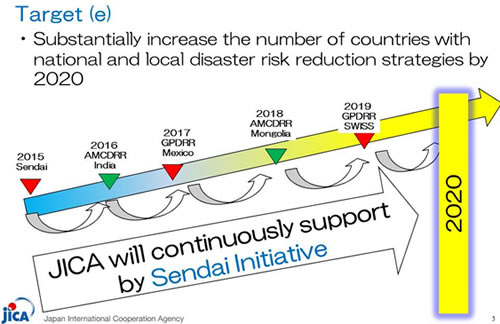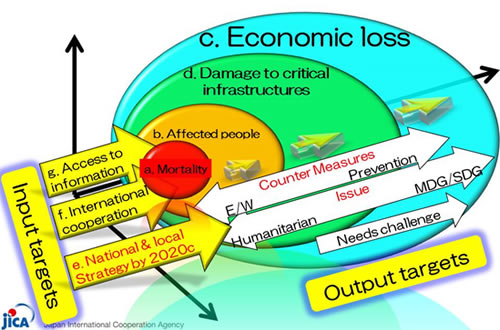Index
Latest Information:
Key points of JICA’s Cooperation for Disaster Risk Reduction
The 2030 Agenda for Sustainable Development Goals (SDGs), which was adopted at the UN Summit in September 2015, basically reflects the principles of "Human Security No One Left Behind" as a whole. Since this is consistent with the Japan's policy on Official Development Assistance, JICA, as a development institution, treats the SDGs as issues of the highest importance, and provides assistance to the various countries requiring Japan's support and cooperation.
Disaster Risk Reduction is not specified in the 17 goals of the SDGs, but many of them touch on the principles of Disaster Risk Reduction. JICA continues to make contributions, not only in the field of Disaster Risk Reduction, but also in all development issues, by mainstreaming DRR.

Figure: SDGs Targets that include Disaster Risk Reduction
JICA's Basic Policy
In the disaster management cycle, JICA makes every effort to be fully prepared for an effective and seamless response to a disaster, firstly, to save lives, secondly, to prevent disasters, and finally, to rehabilitate and reconstruct as soon as possible. JICA also encourages the "Build Back Better" concept to take each disaster, though unfortunate, as an opportunity to build a more disaster-resilient society against future disasters.
Contribution to International Discussions Based on Japanese Experience
As a world-leading development cooperation organization, JICA shares Japan's knowledge in disaster risk reduction. It aims at discussions in the international arena, and contributes to implementing the Sendai Framework for Disaster Risk Reduction. The accumulated disaster risk reduction of know-how and knowledge allows Japan to present suitable solutions to disaster risk reduction issues in developing countries corresponding to each country's level of development, the implementation of disaster risk reduction measures, together with the central government, local governments, local communities, the private sector, academic research organizations, civil society organizations and other related organizations, and the continued improvement of the legal framework to build a disaster-resilient society after a major disaster under the "Build Back Better" concept.
JICA could work with many stakeholders, such as central ministries, local governments, universities, private organizations and communities.
Collaboration with International Partners
JICA had exchanged a Memorandum of Cooperation with the United Nations Office for Disaster Risk Reduction (UNISDR). In this memorandum, JICA and UNISDR promise to jointly promote implementation of the Sendai Framework for Disaster Risk Reduction, along with the development implementation agency, the United Nations Development Programme (UNDP). JICA also collaborates with multilateral and regional development banks, such as the World Bank or the Asian Development Bank, to widely share its knowledge.
In sharing its knowledge and techniques with the world as a disaster-prone country by cooperating with related organizations, JICA supports the building of a disaster-resilient society based on the Sendai Framework. Moreover, without setting cooperation as the end goal, JICA examines and promotes cooperation by individually judging whether or not such cooperation will promote the Sendai Framework.
For JICA, Japanese stakeholders are invaluable partners in sharing the Japanese experiences and know-how with developing countries. To practice disaster risk reduction cooperation more efficiently, JICA strengthens cooperation, not only with the central government, but also with local public bodies, academic organizations, fields of industry and civil society.
Mainstreaming Disaster Risk Reduction in Development
In the promotion of "Human Security" approach and sustainable development, JICA believes that there is a need to build a disaster-resilient society by: (1) prioritizing DRR in the country's government policy; (2) ensuring that disaster risk reduction is incorporated into development plans and programs in all sectors and fields; and (3) increasing prior investments in DRR.
The process includes the evaluation of disaster risks and, for JICA projects, JICA considers DRR, not only in the area of disaster risk reduction, but in all sectors. The process includes the evaluation of disaster risks, followed by the reduction and mitigation of those risks through business projects and plans.
What is "Build Back Better"?
It is important to take precautions to reduce the risk and damage caused by natural disasters. In reality, however, it is difficult for developing countries to allocate enough funds for unexpected disasters in advance. "Build Back Better" is the concept of turning disasters to an advantage by creating a stronger country and society. This is done through the reconstruction of physical infrastructures, living standards, economic and industrial recovery, and the restoration of community environment and culture." Once a disaster happens, not only human life, but also precious time, opportunities for further development, and property built by individuals and companies are gone. A huge amount of funds is then necessary, first, for the disaster response, and then, for the restoration and recovery after the disaster. Moreover, water related disasters occur frequently and tend to affect the same area and repeatedly cause economic harm. People in these areas will be deprived of opportunities for economic development and will not be able to escape the cycle of disasters and poverty. Recovery, with the concept of "Build Back Better" after a disaster, will build a resilient society against future disasters.
Important Targets and International Conferences

Among the seven (7) Global Targets, only Target (e) aims at 2020 because Target (e) affects, decides the contents, and guides to achieve the other targets. JICA supports the partner countries in achieving Target (e) as the highest priority.
Case Study
Sri Lanka "Disaster Management Capacity Enhancement Project Adaptable to Climate Change"
The Ministry of Disaster Management of Sri Lanka and JICA made a Roadmap which, based on the main features of disasters, describes strategies and priority actions to effectively build a safe and resilient Sri Lanka in line with the Sendai Framework.
Case Study
Philippines "The Project on Reconstruction and Recovery from Typhoon Yolanda"
* Movies as output of the data collection survey in the Philippines may be accessed from the following sites:
Relation among the Seven (7) Global Targets of Sendai Framework for DRR

Target (a), "Reduction of mortality rate", is a subset of Target (b), "Reduction of the number of affected people". Likewise, Target (b) is a part of Target (d), "Reduction of damage to critical infrastructure", and Target (d) is also a subset of Target (c), "Reduction of direct disaster economic loss." To build safe and resilient societies against disasters, it is indispensable to take measures through investing on DRR, not only for Target (a), but also for Target (c).




scroll